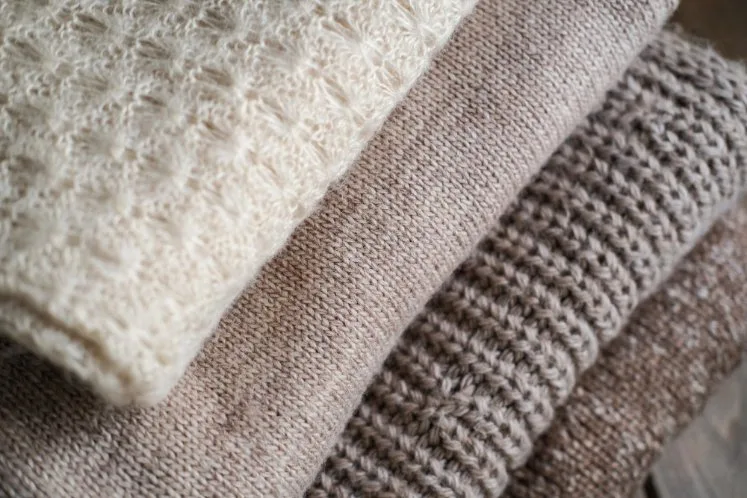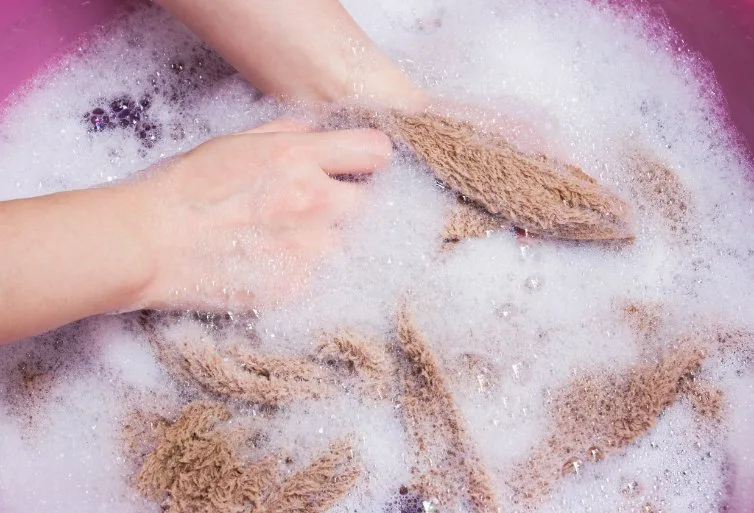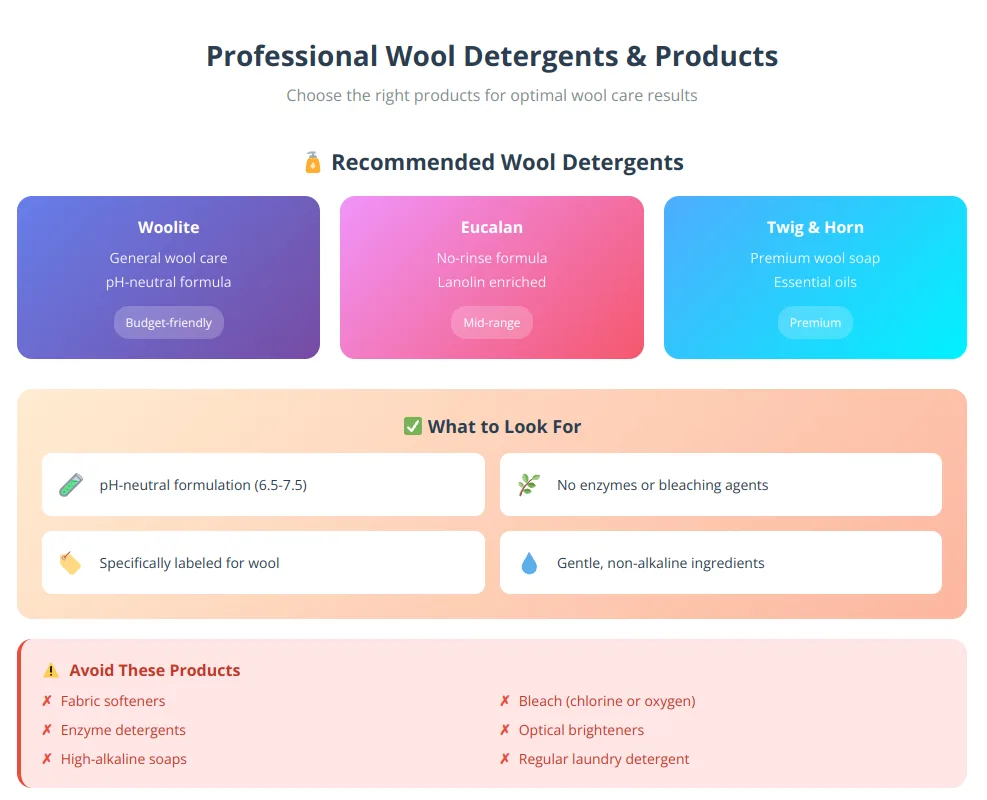Professional Wool Care: From Merino to Cashmere – Complete Maintenance Guide
Caring for wool doesn’t have to be complicated. These natural fibers are actually easier to maintain than most people think. Wool naturally resists odors, stains, and bacteria, which means fewer washes and less work for you. With the right techniques, wool garments can last for decades while staying soft and beautiful.
This guide covers everything from basic washing to professional care secrets that will keep wool items looking their best. Whether dealing with cashmere, merino, or any other wool type, these proven methods will protect your investment and extend the life of every piece.
Table of Contents
Key Takeaways
- Wool naturally repels odors and bacteria, requiring fewer washes than synthetic fabrics
- Proper washing and drying techniques prevent shrinkage and maintain fiber integrity
- Smart storage protects wool from moths and extends garment lifespan
- Regular maintenance reduces the need for professional cleaning
Understanding Wool and Its Unique Properties

Wool fibers contain natural scales and proteins that create exceptional insulating and moisture-wicking abilities. These characteristics make wool one of the most sustainable and long-lasting materials for clothing.
Different Types of Wool and Their Care Needs
- Sheep’s Wool (Including Merino) The most common type, merino wool offers superior softness and temperature regulation. It requires gentle handling but can often be machine washed on delicate cycles.
- Cashmere This luxury fiber from goats needs extra care due to its delicate nature. Always hand wash cashmere or use professional cleaning services. The fibers are shorter and more fragile than sheep’s wool.
- Alpaca Wool Growing in popularity for its superior performance, alpaca wool dries faster than sheep’s wool thanks to hollow fibers. It’s naturally hypoallergenic and requires similar care to merino wool.
- Mohair From Angora goats, mohair creates strong, lustrous fabrics that resist wrinkling. These fibers can handle slightly more aggressive cleaning than cashmere but still need gentle treatment.
Not sure what type of wool you’re working with? Our wool type identification tool helps you identify your fabric type based on visual and tactile characteristics, so you can provide the right care.
Why Wool is a Sustainable Choice
Wool stands out as an environmentally responsible fabric choice. Unlike synthetic materials that shed microplastics, wool biodegrades completely when disposed of. The Material Circularity Indicator by the Ellen MacArthur Foundation gives wool the highest possible score for sustainability.
Wool production also supports carbon sequestration through regenerative farming practices. While synthetic fibers are made from fossil fuels that release stored carbon, wool is created from renewable atmospheric carbon that returns nutrients to soil when the garment eventually breaks down.
The International Wool Textile Organisation (IWTO), which represents the global wool industry, emphasizes wool’s environmental advantages over synthetic alternatives. As the industry’s leading authority, IWTO highlights that wool naturally biodegrades, doesn’t contribute to microplastic pollution, and can be recycled at much higher rates than other fibers
Environmental Benefits of Proper Wool Care:
- Washing less frequently reduces water and energy consumption
- Lower temperature washing decreases carbon footprint
- Longer garment lifespan reduces textile waste
- Natural biodegradability prevents microplastic pollution
Proper Wool Washing Techniques

Can I Wash 100% Wool in a Washing Machine?
Yes, many 100% wool items can be machine washed, but always check the care label first. Look for symbols indicating machine wash capability. When in doubt, hand washing is always the safer option.
Should Wool be Hand Washed or Dry Cleaned?
The answer depends on the specific garment and its construction. Hand washing works well for most wool items and gives you complete control over the process. Dry cleaning is best for:
- Structured garments with interfacing
- Items with multiple fiber types
- Vintage or delicate pieces
- Garments specifically labeled “dry clean only”
Preparing Wool for Washing
Always read care labels before starting any cleaning process. These labels tell you the maximum safe temperature and whether the item can handle machine washing.
If you’re unsure what the symbols on your care label mean, use our interactive care label decoder tool to understand exactly what each symbol means for your wool garments.
Turn wool garments inside out to protect the outer surface from friction. This simple step helps maintain the fabric’s appearance and prevents pilling.
Sort items by color and weight. Never mix heavy wool coats with delicate sweaters in the same load.
Essential Washing Supplies:
- Wool-specific detergent (pH-neutral)
- Clean white towels
- Cool water (20-30°C)
- Mesh laundry bag for machine washing
Hand Washing Step-by-Step
Fill a clean basin with lukewarm water (20-30°C maximum). Add a small amount of wool detergent and mix gently until dissolved.
Submerge the garment completely and gently squeeze the soapy water through the fibers. Avoid twisting, rubbing, or wringing, which can damage the wool structure.
Let the item soak for 10-15 minutes. For heavily soiled areas, gently work the detergent through with your fingers.
Drain the soapy water and rinse thoroughly with clean water at the same temperature. Continue rinsing until no soap residue remains.
For visual learners, this step-by-step demonstration shows exactly how to hand wash delicate wool items safely. The techniques shown work perfectly for cashmere, merino wool, and other fine knits.
Machine Washing Guidelines
Modern washing machines often include wool cycles that use gentle agitation and controlled temperatures. Follow these settings for best results:
Optimal Machine Settings:
- Wool or delicate cycle
- Water temperature: 20-30°C (cold to lukewarm)
- Low or no spin speed
- Reduced load size
Place delicate items in mesh bags to prevent stretching and tangling. Remove garments immediately after the cycle completes to prevent wrinkles from setting.
Do You Wash Wool at 20 or 30 Degrees?
Both temperatures work for wool, but 20°C is safer for delicate items. Use 30°C for sturdier wool garments that need deeper cleaning. Never exceed 30°C, as higher temperatures can cause irreversible shrinkage and felting.
Is 30 Degrees a Cold Wash?
In wool care terms, 30°C is considered a warm wash. Cold washing typically refers to 20°C or below. For wool, always err on the cooler side to prevent damage.
What Spin Should I Wash Wool On?
Use the lowest spin setting available, typically 400-600 RPM. High spin speeds can stretch and distort wool fibers. Some delicate items benefit from no spin at all.
Expert Drying and Reshaping Methods
Proper drying prevents shrinkage and maintains the original shape of wool garments. Never hang wet wool items, as the weight of water can permanently stretch the fibers.
Air-Drying Best Practices
Gently squeeze out excess water without wringing. Roll the damp garment in a clean, dry towel to absorb more moisture.
Lay the item flat on a fresh towel, reshaping it to original dimensions while damp. Pay special attention to sleeves, necklines, and hemlines.
Choose a flat surface in a well-ventilated area away from direct sunlight and heat sources. Flip the garment once the top side feels dry to ensure even drying.
How to Restore Wool After Drying
If wool becomes stiff after drying, the steam method can help restore softness. Hang the garment in a steamy bathroom while running a hot shower. The moisture will naturally relax the fibers and remove wrinkles.
For items that have lost their shape, gently dampen with a spray bottle and reshape while the fibers are relaxed. Allow to air dry flat again.
Emergency Shrinkage Recovery
If wool accidentally shrinks, try this recovery method:
- Fill a basin with lukewarm water and add hair conditioner
- Soak the shrunken item for 30 minutes
- Gently stretch the garment back to size while wet
- Rinse thoroughly and dry flat
This method works best on lightly shrunk items and may not restore severely damaged pieces.
If your wool item has accidentally shrunk, don’t panic. This video shows the exact technique for safely stretching wool back to size using the conditioner method described above.
Seasonal Wool Care Calendar
Following a structured seasonal approach ensures wool garments receive appropriate care year-round. This calendar provides a clear roadmap for maintaining wool items through every season.

By following this seasonal schedule, wool garments maintain their quality and longevity. Each season’s specific tasks address the unique challenges and opportunities that time of year presents for wool care
Spring Preparation (March-May)
- Wash items before summer storage
- Set up moth prevention measures
- Inspect for damage needing repair
- Organize climate-controlled storage
Summer Storage (June-August)
- Store clean items in breathable containers
- Check storage areas for temperature control
- Monitor for moth activity
- Rotate stored items monthly
Fall Preparation (September-November)
- Remove from storage and air out
- Steam to remove wrinkles
- Check for any damage during storage
- Prepare for active wear season
Winter Maintenance (December-February)
- Rest garments 24 hours between wears
- Use steaming for wrinkle removal
- Spot clean minor stains immediately
- Monitor for pilling and address promptly
Advanced Maintenance and Care
Professional-level maintenance techniques can dramatically extend wool garment lifespan. These advanced methods go beyond basic washing to preserve wool’s natural properties.

Regular application of these advanced techniques prevents minor issues from becoming major problems. Professional maintenance approaches save money and preserve garment quality over decades.
How to Remove Pilling from a Wool Sweater
Pilling occurs when short fibers work their way to the surface and tangle together. Use these tools to safely remove pills:
- Wool comb: Work in one direction with light pressure
- Pill remover: Electric shavers designed for fabric use
- Fabric shaver: Gentle removal of surface pills
- Small scissors: Carefully snip individual pills
Always test removal methods on a hidden area first. Work slowly to avoid damaging the underlying fabric.
How to Make Wool Last Longer
Daily Care Habits:
- Allow 24-hour rest periods between wears
- Brush woven garments lengthwise after wearing
- Address stains immediately
- Store properly when not in use
Long-term Strategies:
- Rotate garments to prevent overuse
- Professional cleaning when needed
- Regular moth prevention measures
- Proper seasonal storage
How to Freshen Up Wool Without Washing
Wool’s natural properties make it easy to refresh without water:
- Air drying: Lay flat for one hour to remove odors
- Steam treatment: Hang in steamy bathroom
- Fresh air: Outdoor airing removes most odors
- Brushing: Removes surface dirt and refreshes fibers
How to Get Smell Out of Wool
For persistent odors, try these methods before washing:
- Sprinkle baking soda on the garment, let sit overnight, then brush off
- Use white vinegar in a spray bottle (test first)
- Professional cleaning for severe odors
- Activated charcoal sachets in storage
How to Get Musty Smell Out of Wool Without Washing
Cedar blocks and lavender sachets naturally eliminate musty odors. Place items with these natural deodorizers in a sealed container for 24-48 hours. Fresh air circulation also helps remove storage odors.
How to Make Wool Fluffy Again After Washing
If wool becomes flat after washing, use these restoration techniques:
- Steam treatment in bathroom
- Gentle brushing with a soft-bristled brush
- Air fluffing by shaking gently
- Professional pressing if needed
Professional Wool Detergents and Products
What Detergent is Safe for Wool?
Choose pH-neutral detergents specifically formulated for wool. Avoid regular laundry detergents that contain enzymes, bleach, or optical brighteners.
Wondering how much detergent to use for your specific garment? Our washing calculator tool provides exact measurements based on your wool type, garment size, and soil level.
Choosing the right products makes the difference between wool that lasts decades and wool that deteriorates quickly. Professional-grade detergents and proper product selection protect your investment.

Quality wool care products may cost more initially but save money long-term by extending garment life. Always check product labels and choose items specifically formulated for wool fibers.
Recommended Product Types:
- Woolite for general wool care
- Eucalan for no-rinse washing
- The Laundress Wool & Cashmere Shampoo
- Twig & Horn Wool Soap with lanolin
According to The Woolmark Company, the global authority on wool standards, choosing the right detergent is crucial for maintaining wool’s natural properties. Their comprehensive care guidelines emphasize using pH-neutral detergents specifically formulated for wool, avoiding regular laundry detergents that contain enzymes, bleach, or optical brighteners.
Can You Wash Wool with Baby Shampoo?
Yes, baby shampoo works as an emergency wool cleaner because it’s gentle and pH-balanced. Use sparingly and rinse thoroughly. However, specialized wool detergents provide better results and fiber protection.
Is Fabric Softener OK for Wool?
Avoid fabric softeners on wool. They can coat the natural fibers and reduce wool’s ability to regulate temperature and wick moisture. The natural lanolin in wool provides sufficient softness.
Can I Wash Wool with Vinegar?
White vinegar can help remove odors and restore pH balance, but use it sparingly. Add 1/4 cup to the rinse cycle or use in spot treatments. Test on an inconspicuous area first.
Smart Storage Solutions
Proper storage protects wool from damage while maintaining garment shape and preventing pest problems. Smart storage solutions address climate control, moth prevention, and structural preservation.

Investment in proper storage pays dividends in garment longevity. These storage methods prevent the most common causes of wool damage during non-wear periods.
Proper Folding vs. Hanging
Fold knitted wool items and store flat in drawers or on shelves. Hanging stretches the fibers and creates permanent distortion.
Hang woven wool garments on padded or wooden hangers. Wire hangers can create permanent creases and stress points.
Climate-Controlled Storage
Ideal Storage Conditions:
- Temperature: 18-21°C (65-70°F)
- Humidity: 45-55%
- Dark environment
- Good air circulation
Avoid basements and attics where temperature and humidity fluctuate wildly.
Natural Moth Prevention
Cedar blocks, lavender sachets, and rosemary sprigs naturally repel moths without chemical treatments. Replace these natural deterrents every 6 months for continued effectiveness.
Clean all items before storage, as moths are attracted to food stains and body oils.
Effective Natural Moth Deterrents:
- Cedar blocks or cedar-lined storage
- Dried lavender in sachets
- Rosemary and mint leaves
- Diatomaceous earth (food grade)
Spot Cleaning and Stain Removal
Emergency Stain Treatment
For specific stain removal guidance, our wool stain treatment tool provides step-by-step instructions tailored to your exact stain type and urgency level.
Act quickly when spills occur. Blot (don’t rub) with a clean cloth to absorb liquid before it penetrates the fibers.
Common Stain Solutions:
- Oil stains: Sprinkle cornstarch, let sit 30 minutes, brush off
- Wine/juice: Blot with cold water, then white vinegar solution
- Sweat stains: Mix water and white vinegar (1:1 ratio)
- Food stains: Cold water followed by gentle wool detergent
When to Seek Professional Help
Professional cleaning becomes necessary for:
- Stubborn stains that resist home treatment
- Structured garments with padding or interfacing
- Vintage or valuable pieces
- Items with mixed fiber content
- Heavy soiling or significant odor issues
Choose cleaners certified in wool care who use wool-safe cleaning products.
Wool vs. Other Fabrics: Care Comparison
Wool requires different care than other natural fibers. Understanding these differences helps prevent damage.
| Fabric | Washing Frequency | Temperature | Special Needs |
|---|---|---|---|
| Wool | Every 5-10 wears | Cold (20-30°C) | Gentle handling, flat drying |
| Cotton | Every 1-3 wears | Warm (40°C) | Can handle regular cycles |
| Silk | Every 3-5 wears | Cool (30°C) | Hand wash preferred |
| Linen | Every 2-4 wears | Warm (40°C) | Can be pressed while damp |
Unlike cotton and polyester fabrics, wool doesn’t absorb moisture in the same way. This natural property means wool garments stay fresher longer and need less frequent washing.
Cost-Benefit Analysis of Proper Wool Care
Investment Protection
Quality wool garments represent significant investments. Proper care can extend their lifespan from 5-10 years to 20+ years, making the cost per wear remarkably low.
Financial Benefits:
- Reduced replacement costs
- Lower professional cleaning bills
- Energy savings from less frequent washing
- Maintained resale value
Professional vs. Home Care Costs
Home care for most wool items costs under $2 per cleaning (detergent and water). Professional dry cleaning ranges from $8-25 per garment. Learning proper home care techniques can save hundreds annually for wool-heavy wardrobes.
Troubleshooting Common Wool Problems
Even with careful handling, wool problems occasionally occur. These troubleshooting guides provide step-by-step solutions for the most common wool care challenges.

Quick action using these proven methods can save damaged wool items. Most wool problems are reversible when addressed promptly with the right techniques.
Does Wool Shrink Every Time You Wash It?
No, wool only shrinks when exposed to heat, agitation, or pH changes that cause the fibers to lock together (felting). Proper washing techniques prevent shrinkage.
Will Wool Shrink at 30 Degrees?
Wool can shrink at 30°C if combined with agitation or pH shock. The temperature alone won’t cause shrinkage, but it increases the risk when combined with other factors.
Should Wool Not Get Wet?
Wool can safely get wet during proper washing. However, avoid soaking wool for extended periods or exposing it to rapid temperature changes while wet.
Is Delicate Wash the Same as Hand Wash?
Delicate machine cycles approximate hand washing but aren’t identical. Hand washing provides more control over temperature, agitation, and timing. For valuable pieces, hand washing remains the safest option.
How Long Can You Wear Wool Without Washing?
Wool’s natural odor resistance allows 5-10 wears between washings for most garments. Base layers and items in direct contact with skin may need more frequent cleaning.
How Did People Wash Wool Before Dry Cleaning?
Historical wool care involved careful hand washing in cool water with gentle soap, often made from natural ingredients like soapwort plants. Items were laid flat to dry and regularly aired to prevent odor buildup.
Why Can’t You Put Wool in the Washing Machine?
This belief is outdated. Many modern wool items can be machine washed using proper techniques. The key is using appropriate settings and understanding which items are suitable for machine care.
What Happens if You Don’t Dry Clean Wool?
Most wool items don’t require dry cleaning. Hand washing or careful machine washing often provides better results while being gentler on fibers. Dry cleaning uses harsh chemicals that can strip natural oils from wool.
For related fabric care guidance, check out our comprehensive guides on cotton care, linen maintenance, and silk care.
Frequently Asked Questions
How often should wool garments be washed?
Wool typically needs washing every 5-10 wears, depending on the garment type and how it’s worn. Base layers need more frequent cleaning than outer garments.
Can wool garments be dried in a dryer?
Only if the care label specifically allows it. Most wool should be air-dried flat to prevent shrinkage and maintain shape.
What’s the best way to store wool during summer?
Clean items thoroughly, then store in breathable cotton bags or cedar-lined containers in a cool, dry place. Add natural moth deterrents like cedar blocks or lavender sachets.
How can I prevent pilling on wool sweaters?
Turn garments inside out before washing, avoid washing with rough fabrics, and use gentle cycles. Remove pills promptly with a fabric comb or pill remover.
Is it safe to iron wool garments?
Use low heat settings with steam, and place a pressing cloth between the iron and wool. Many wool garments can be refreshed with steam instead of ironing.
What should I do if my wool sweater shrinks?
Try the hair conditioner method: soak in lukewarm water with conditioner, gently stretch back to size, then rinse and dry flat. This works best for minor shrinkage.
How can I get personalized care instructions for my specific wool garment?
We’ve created specialized tools to help with common wool care challenges. Use our care label decoder to understand washing symbols, stain treatment guide for specific stain removal, wool identifier to determine your fabric type, and washing calculator for precise detergent and temperature recommendations.
Conclusion
Proper wool care combines traditional techniques with modern understanding of fiber science. These natural materials offer exceptional durability, comfort, and sustainability when maintained correctly. The key principles are gentle handling, appropriate temperatures, and respect for wool’s unique properties.
Regular maintenance prevents most problems and extends garment life significantly. Simple practices like the 24-hour rest period, steam refreshing, and proper storage can keep wool items looking new for decades. When washing becomes necessary, gentle techniques and specialized products protect the investment while ensuring thorough cleaning.
The environmental benefits of choosing and caring for wool properly extend beyond individual wardrobes. Wool’s biodegradability, reduced washing requirements, and long lifespan make it one of the most sustainable fabric choices available. By following these care guidelines, consumers can enjoy the comfort and performance of wool while minimizing their environmental impact.
Key Recommendations:
- Invest in quality wool-specific detergents for best results
- Allow adequate rest time between wears to maintain fiber resilience
- Use professional cleaning judiciously for complex or valuable garments
- Implement seasonal storage routines to prevent moth damage
- Address stains and problems immediately to prevent permanent damage
Take advantage of our specialized wool care tools for personalized guidance on care labels, stain removal, wool identification, and washing calculations.
Understanding wool care transforms these garments from high-maintenance items into wardrobe workhorses that improve with proper attention. The techniques in this guide ensure that wool items remain comfortable, beautiful, and functional for many years to come.

